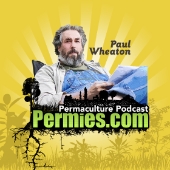posted 9 years ago
I grow a lot of what we eat on a south-facing hillside that is quite steep. What is nice about south-facing hills is that they extend your growing season significantly. For every 5 degrees of slope, it's like moving your land 100 to 150 miles south. So a 25 degree hillside is like living 500+ miles further to the south. That slope absorbs heat, and gives you a larger growing surface, more sunlight, etc. It will heat up sooner in the spring and maintain soil warmth longer into the fall.
While I don't do hugels on a hillside, I pile organic material on the down-hill side of my fruit trees. On our hillside, I've got 2 avocados, 3 figs, 5 asian pears, 4 peach, 2 cherry and 2 nectarines. Below each of these trees is a berm of branches, leaves, pumpkin/tomato/gourd/cucumber/sweet potato vines . . . just tons and tons of carbon from yard waste, garden waste, tree branches, wood chips, etc. Over the years, those brush piles have slowly rotted down and created amazing soil beneath.
Why the down-hill (south) side? Because the uphill side is shaded by the tree, but the downhill side absorbes the full brunt of the hot summer sun. The trees have benefited tremendously, but I also plant other stuff around them and everything does better as a result. Vining plants cover the piles during the summer—I'll have to reach up onto the top of the pile to pick a watermelon. In the heat of the summer, the sun hits those piles, not the earth below, keeping the soil cooler and saving soil moisture. During the winter, the piles are a great habitat for lizards (my snail and slug patrol). With each passing year, the soil below the trees continues to get richer and darker.
So . . . if you are gardening on a slope and are creating an integrated food forest, that might be one option. Particularly if your slope is south facing. It's a whole lot easier to pile stuff up and leave it to slowly rot, than it is to build hugals. After a while, those brush piles act as a like of terrace, capturing falling leaves and other organic material. They look somewhat like a nest below each tree. Some of them are tall enough that I can stand of them when I pick fruit --- another added bonus.
I don't know if you have dug swales, but that is a long-term step that is actually regenerative in building soil, as organic material collects and breaks-down in the swales. If you have a swale, pile your organic material in the swale (where it will break down faster) or on the uphill side, where it will keep the soil moist and wash down as it decomposes. It sounds like drainage wouldn't be a problem on your sandy/rocky land, so a swale might be a nice place to collect a bit of water after larger storms, but then infiltrate it and moisten your carbon/composting plant material in the bottom of the swale. In a couple of years, you should have a couple of inches of good soil in which to grow your plants.
"The rule of no realm is mine. But all worthy things that are in peril as the world now stands, these are my care. And for my part, I shall not wholly fail in my task if anything that passes through this night can still grow fairer or bear fruit and flower again in days to come. For I too am a steward. Did you not know?" Gandolf







